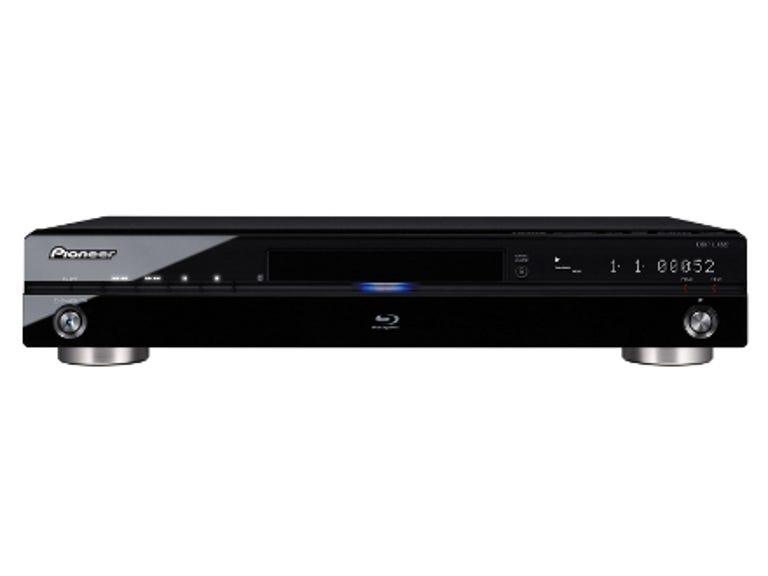 Why You Can Trust CNET
Why You Can Trust CNET Pioneer BDP-LX52 review: Pioneer BDP-LX52
Considering how pricy the flagship BDP-LX52 Blu-ray player is, it has a fair amount of flaws, such as its relatively slow disc-loading times and inability to play back media via its USB port. But such problems are all outweighed by its absolutely fantastic sound and video quality
Pioneer's Kuro range of plasma TVs were met with an avalanche of awards, but its Blu-ray players have also consistently been among the best performers of their type. The BDP-LX52 is the company's latest flagship model. Priced at about £500, it's obviously designed to appeal to picture purists rather than bargain hunters.
The Good
The Bad
The Bottom Line
Conservative styling
The BDP-LX52 may be pricy, but it doesn't exactly look all that flash. Although other manufacturers are starting to slim down their Blu-ray players, Pioneer has made little attempt to do so. The BDP-LX52 is quite tall, at 83mm, and relatively wide, measuring 420mm. The glossy black finish on the front and the central, ice-blue LED (dimmable from the remote) are appealing enough, but the overall look is quite conservative.
Get connected
The player has a decent line-up of sockets, but a set of analogue surround-sound outputs is notably absent. This means that, while the BDP-LX52 has on-board decoding capability for high-resolution audio formats like DTS-HD MA, DTS-HD High-Resolution Audio, Dolby TrueHD and Dolby Digital Plus, you need to hook it up to an HDMI-enabled receiver to be able to take advantage of it.
What you do get on the connection front are HDMI, component and composite video outputs, along with optical digital and stereo phono audio connectors. There's also an Ethernet socket for connecting the player to the Internet so you can access interactive BD-Live content, and a USB port for adding extra storage space.
As the player has 1GB of on-board storage for saving BD-Live extras, you may not need to add USB storage at all. One issue we have with the USB port, however, is that it can't be used to play back your own media files -- you can only use it for storage. If you want to play formats like DivX, JPEG and MP3, you'll have to burn these files to CD or DVD first. The player also lacks any media-streaming capabilities, so it can't connect to a PC over a network to play files from a Universal Plug and Play server, unlike some other recent players and TVs.
Nevertheless, the BDP-LX52 is very easy to set up, as it guides you through the initial configuration process and even offers a number of picture presets that are optimised for different types of displays (Kuro, plasma, LCD and projector).
Outstanding pictures
The BDP-LX52 really shines in terms of its picture quality. The player can handle 1080p/24p output, while also supporting both 48-bit Deep Color and xv Color. More importantly, the pictures it delivers from Blu-ray discs really are a significant step above much of the competition. Images are exceptionally detailed, and feature colours that are so rich and punchy they practically leap from the screen. It's also capable of mustering up bags of contrast, giving movies a real cinematic depth and helping the player to render shadow detail beautifully. It's also a fine DVD player, with upscaled films refreshingly devoid of scaling artefacts and jagginess.
The BDP-LX52's sound quality is also highly impressive, partly because it features Pioneer's PQLS technology. This works to reduce audio judder and helps produce a more natural, analogue-style sound. Previously, Pioneer only offered it on stereo signals, but here it works on multi-channel output too.
Pioneer still hasn't got on top of the slow disc-loading issue that has affected its other players, however. More complicated discs can take anything up to a minute to load, which is disappointing in a new-generation player like this.
Conclusion
The Pioneer BDP-LX52 is far from perfect. It lacks multi-channel analogue outputs, can't play back media via its USB port and can be slow to load discs. But it still impressed us greatly, due to its excellent video-playback quality. Simply put: it delivers some of the most pristine hi-def images we've yet seen from a Blu-ray player.
Edited by Charles Kloet
